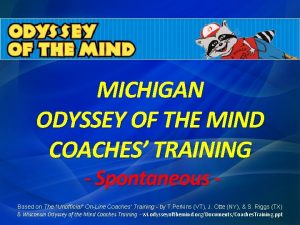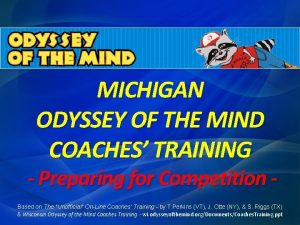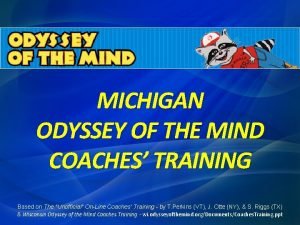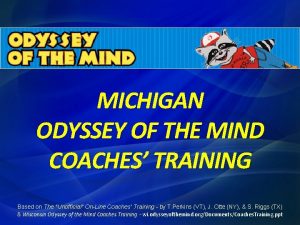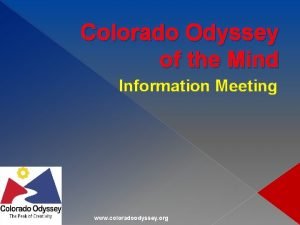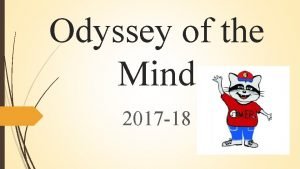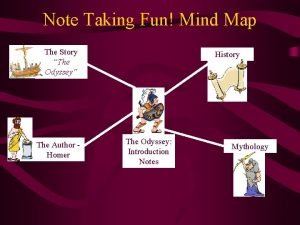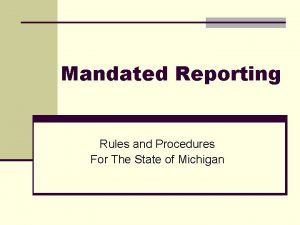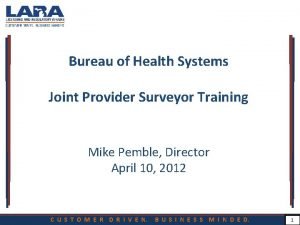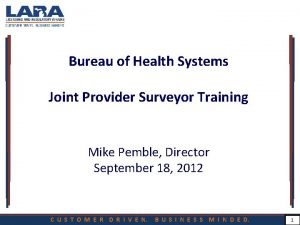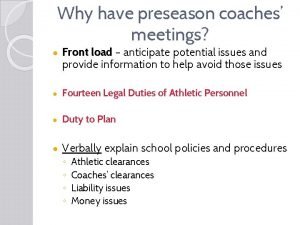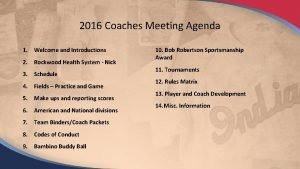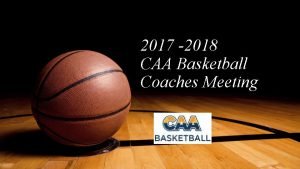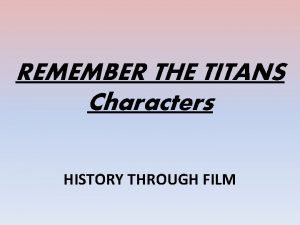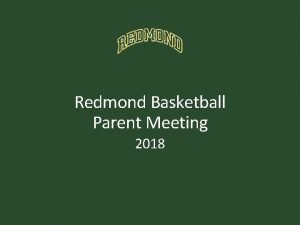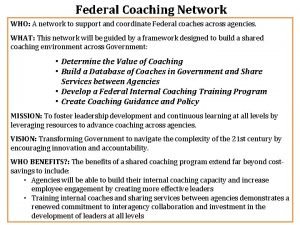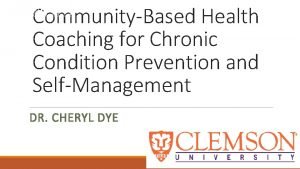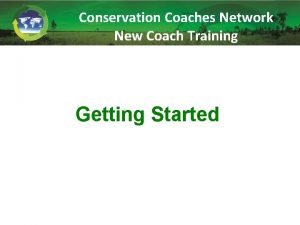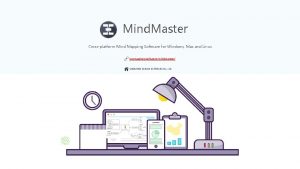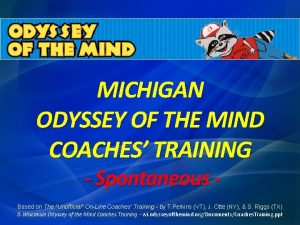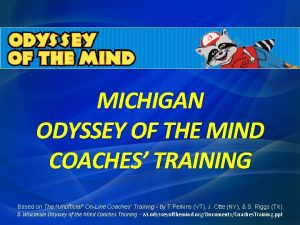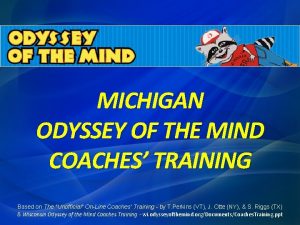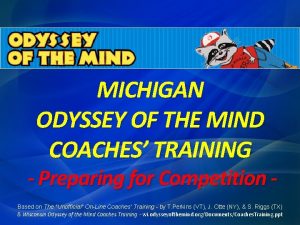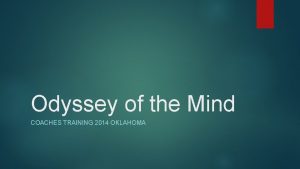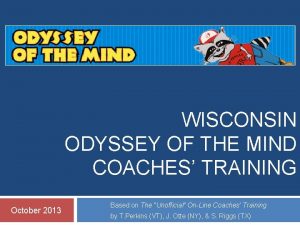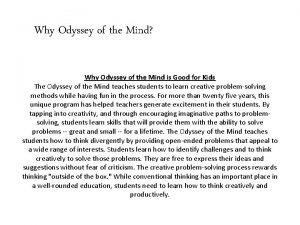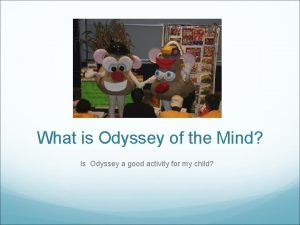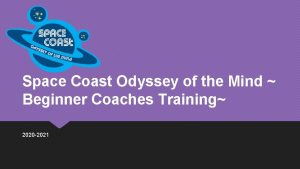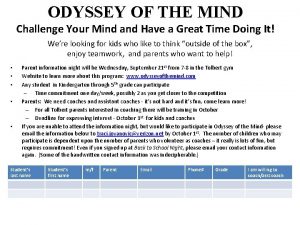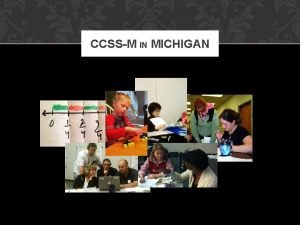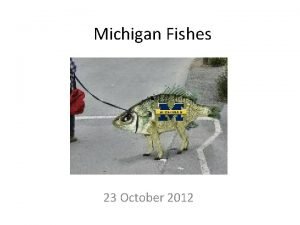MICHIGAN ODYSSEY OF THE MIND COACHES TRAINING Spontaneous


















































- Slides: 50

MICHIGAN ODYSSEY OF THE MIND COACHES’ TRAINING - Spontaneous - Based on The “Unofficial” On-Line Coaches’ Training - by T. Perkins (VT), J. Otte (NY), & S. Riggs (TX) & Wisconsin Odyssey of the Mind Coaches Training - wi. odysseyofthemind. org/Documents/Coaches. Training. ppt

Before We Begin Two main references in today’s presentation PG 5 CM 1

Clarifications Review Clarify - “to make (an idea, statement, etc. ) clear or intelligible; to free from ambiguity. ” Dictionary. com • If a team questions the interpretation of a limitation, or is not sure if an aspect of its solution is allowed or meets the problem’s requirements, it may request a clarification. • Anyone requesting a clarification must cite the rule in question.

Clarifications Review There are two types of clarifications General Clarifications amend or further explain a problem’s limitations without revealing information about a team’s solution. All general clarifications are posted on www. odysseyofthemind. com/clarifications Team-Specific Clarifications pertain to a particular team’s solution. These are confidential and are not published

Clarifications Process • General clarifications are posted on CCI website and take precedence over limitations listed in the problem • It is important that teams keep current on all general clarifications issued throughout the year • A list of clarifications by problem can be found on the CCI website www. odysseyof themind. com/clarifications

Clarifications Process continued…. Make sure to check for clarifications regularly as they will be posted throughout the tournament season.

Clarifications Process continued…. Should your team wish to submit a clarification: • Login in to the member area • Click on the “Clarifications” link

Clarifications Process continued…. You will guided through a series of questions. Remember: • You will need to be specific • You will need to specify the rule or rules that you are questioning.

Clarifications Process continued…. • All clarifications are answered by CCI within seven days of receipt • Copies of all clarifications are sent to the International Problem Captain for the long-term problem in question and the Association Director for the association from which the question came • If your team submits a clarification you will need to bring copies of the email response and submit it with your competition paperwork


• A problem that is presented to the team members only on the day of competition • Problems are secret until the team actually competes • Problems must remain secret after the team competes • All Regional and State competitions use the same problem set • Problem set defined by National Oot. M organization • All teams in the same Long Term Problem/Division compete in same Spontaneous Problem

• Only team members compete • No coaches, parents, siblings • Only team members are permitted in the Spontaneous Area • Exception – Holding Room • One coach or team parent permitted into Holding Room • A maximum of 5 team members may solve the problem • The others must sit quietly and watch their team • No talking, no cheering, no groaning, no faces, etc. • If they cannot sit quietly, they may be asked to leave the room and sit outside the door

= Total Score 350 Points Spontaneous 100 Points 29 % Style 50 Points 14 % Long-Term 200 Points 57 %

• Train the team on problem solving processes • • • Problem types Team roles Team behavior Interacting with the judges How best to solve the problem types • This is NOT Outside Assistance • You can tell them everything in these slides

• Practice with them • Practice Spontaneous at every team meeting • Practice multiple types of problems • Simulate actual competition conditions • • Team entry into Spontaneous Room Behavior Team selecting competitors Team thanks and exit • Practice at the start of meetings • Enlist parents to help judge

• When the team has finished their practice problem, deconstruct the solution • • • Take 5 minutes after they solve the problem What do they think they did well? What do they think they did poorly? What could be done better? How could they have scored more points? • Repeat the same problems to learn from mistakes and refine/reinforce good parts • Tweak or change the problem slightly

Tips and Advice • Be sure to dedicate time to practice Spontaneous is almost 30% of your total score • Practice reacting to mistakes Accidents often happen! • Help the team develop confidence in risk taking • Spontaneous scores often impact a team’s placement at tournaments CM 37

Spontaneous Problem • Spontaneous problems come in three types: • Verbal - problems require verbal responses. Teams may incorporate improvisation or dramatization. They are scored for common and creative responses. • Hands-on - problems require teams to physically create a tangible solution. Each problem has its own specific scoring categories. • Verbal/Hands-on (Hybrid) – problems require team to create a tangible solution and include some type of verbal component. Teams are scored on both tangible solution and verbal presentation. PG 26 CM 34

• Reading the problem • Statement of what needs to be done • Description of task and time limits • Description of scoring • “I repeat…” stresses the most important parts • Scoring • How are points awarded? • May include how well team works together • Try to identify the portion of the scoring that will produce the highest score - exploit it!

• Time limits • Clearly defined in statement of problem • Typical timing • X minutes for Part 1, often called “Thinking Time” • Y minutes for Part 2, often called “Response Time’ OR • Z minutes for entire solution period – this can trip up novice teams

• Can we talk to the judges? • Teams can always ask the judges questions • Usually once time has started • Will usually count against your time • Can we talk to each other? • Usually Yes when brainstorming • Usually Yes in Hands-On or Verbal/Hands-On • Usually No in Verbal • If talking is permitted, encourage it!

• Team Roles • Scoring analyst • Understand the score • Time minder • You can always ask “how much time is left? ” • Moderator • NOT the boss, helps lead the brainstorming • Materials analyst • For Hands-On, how to use materials effectively • Brainstorming – everybody

Spontaneous Strategies Think • • • Plan • • • Test • Act • Brainstorm possible solutions Remember that all ideas are team property Listen to your teammates and build on their ideas How are we going to execute our solution What materials do we use and how Who will do what and when Is it going to work, do we need to adjust Present for score

• Help team identify strengths and weaknesses • • • Who has limited verbal skills Who gets tongue-tied Who is quick witted, funny, original Who has good hand/eye coordination Who has good materials manipulation skills • Folding / Cutting / Taping • Building / Construction • Who can work quickly

• Listening while the problem is read is important • Score, score • Understand scoring requirements and exploit them • Pay attention to “works well together” and “creativity” • Spontaneous practice can be a team building opportunity • Learn your team’s dynamics • Help the team to learn to work together better • If they don’t say you can’t do it, ask, or try!

• Practice • As many types of verbal problems as possible • Stress the creativity of responses • • • Humorous Rhyming, word play and tone or inflection Juxtaposition of ideas (contrast ideas) Use of words in novel or unexpected ways Intentional misuse of a word or phrase for effect • Identify strong versus weak team members • Who has limited verbal skills • Who gets tongue-tied • Who is quick-witted, funny, original

Verbal Strategies • Think time & brainstorming If talking is permitted, brainstorm If talking is not permitted, brainstorm silently Think of as many responses as possible Think “outside the box”, go for unusual and creative • Use alternate definitions • • • Example: Name something green • Common answers; trees, grass, leaves • Uncommon; solar power, Green. Peace, greenhorns • Use word play • Example: “I used to be Snow White but I drifted. ”

• More ways to increase creative answers • Be specific with details • Use adverbs and adjectives to enhance response • Response time & getting un-stuck • Relax, try to remember brainstormed ideas • Build-on previous response, add detail • Follow-on previous response, give a similar response • As a last resort, repeat an answer

• Scoring • Number of responses per team member • Point difference between Common and Creative • If responses are limited and have a high point difference, take time to make responses creative • BE SURE TO USE ALL RESPONSES!

• Possible questions to ask judges • • • Can we talk during think time? Who goes first? Which direction do we go? Can we go out of turn if someone gets stuck? How much time is left? • Remember, time will not stop while you are asking questions

Verbal/Hands-on Spontaneous Problem • Will have aspects of both a Verbal and a Hands-On Spontaneous problem • Team may have to manipulate given materials and describe possible uses • Could be a 2 part problem: • Build/construct something out of given materials • Tell a story or describe what they have just built

Hands-On Spontaneous Problem • Look carefully at the problem and ask questions • • • Do you need multiples of the SAME thing? If you have tools, can they be part of the solution? Can you reach over, under, around, through? Does the weight always have to go on the top? Can the materials be altered, reinforced, repurposed? • Some materials are there to distract • Have your team practice finding ways to reinforce, attach, lengthen, strengthen assorted materials. • Think paper, straws, paper clips, mailing labels, yarn…

• Common types of Hands-ON • Build something to meet a specific criteria • A tower that will hold items • A bridge that will span a distance • Use materials to manipulate objects • Place objects in bounded scoring locations • Move objects for as long/as far as possible • Time • Think time (plan/assemble/TEST!) • Response time (present solution for score) • Talking is almost always permitted

• Scoring • Understand scoring requirements • Identify what has to be done to maximize score • Common scoring elements • “How well team works together” teamwork • Usually worth 1 to 10 points • “Creativity of solution” stress use of materials in unusual ways or combinations • Usually worth 1 to 15 points • Don’t get so focused on details that you forget to present your solution within the time limit

• Think time (plan/assemble/TEST) • Inventory materials to manipulate (can be broken, cut, torn, bent , etc. ) • Toothpicks, clay, tape, labels, straws, rubber bands, paperclips, string, pipe cleaners, paper/plastic cups, spaghetti, unsharpened pencils, tin foil, cotton balls • Materials to use as tools (cannot manipulate) • Usually marked with Yellow tape • Scissors, rulers, containers, markers • Ask: Can tools be used as part of the solution? • Look for materials to use in creative ways

• Think time (plan/assemble/TEST) continued… • Assemble • If multiple items required, analyze components • SHARE COMMON MATERIALS!!! • Use materials carefully • Once crumpled, tin foil doesn’t flatten easily • Once pulled up, tape doesn’t re-stick well • Use time wisely • Build to merge all components into final product • safely transport creation to presentation area, if required

• Think time (plan/assemble/TEST) continued… • Beware “throw-away” materials • Some items will be included that look useful, but may be there to distract • Balance functionality with creativity • Avoid creating a beautiful/elegant solution that doesn’t work • TEST THE SOLUTION!!! • ALWAYS test the solution before it has to be used for score!!!

• Response time (present solution for score) • Demonstrate the solution • Work as a team • Possible questions to ask judges May we use the tools as part of the solution? May we lean over the boundary lines? May we break/cut/modify materials? If building a weight bearing structure, does the weight have to be at the top of the structure? • How much time is left? • •

• Identify strong versus weak team members • Who has good hand/eye coordination? • Who has good materials manipulation skills? • • Folding Cutting Taping Constructing • Who can work quickly? • Who doesn’t fidget or play with materials?

• Check-in • Arrive 15 minutes before scheduled Spontaneous time • Check in at the check-in table • The coach should collect all cell phones, back packs and extra clothing (give these to someone else) • Cell phones etc are not allowed in the holding room! • Team and 1 coach will go to the Holding room • Holding Room • Last minute instructions, encouragement, focusing… • When team is called, confirm team identity with the “runner” using Spontaneous Ticket • Coach says good-bye and proceeds to the pick-up area • Team goes off with the runner to spontaneous room

. • Spontaneous Room • Team enters and introduces themselves • Judges announce problem type • 5 competitors selected immediately • Be sure team decides this ahead of time • Non-competing team members sit down • Must be quiet (no gestures or facial expressions) • Only competitors in the room can talk about problem • Judge reads problem and time limits • Team has copies to follow along • Problem starts

. • Team attempts to solve problem • Problem stops • Team finishes or Time keeper calls “Time” • If team member is in middle of verbal response, they may complete it • Thank the judges • Team will NOT be told score • Scores will be posted on-line after the competition • Runner escorts team to Pickup Area • Team members should not discuss their Spontaneous problem until after World Finals!

• BE • Polite and attentive • Positive, supportive, encouraging • DO NOT • Criticize or argue with each other or judges • Disrupt or behave inappropriately • DO • Have fun • Give your best effort

• Be polite and attentive • Listen carefully and follow instructions promptly • Look at the judges when talking to them • Speak loudly and clearly • Do NOT mumble or rush your words • Introduce your team • Be sensible, time is limited • Include membership name, membership number, long term problem and division • Be sure to thank the judges when you’re done

Still not sure how to Coach Spontaneous? ? ?

• Spontaneous Kits • Thinking Cap - http: //www. thinkingcapllc. com/ • CCI - http: //www. odysseyofthemind. com/ • Spontaneous Kits • Spontaneous Problem Books • Internet • Many Spontaneous and Spontaneous-type problems • Just search “Spontaneous problems” • Spontaneous Nights • Participate if the opportunity comes up • Organize one yourself if the opportunity does not come up

Questions, Questions What do you want to know? How can we help you?

More Resources Other helpful resources: • Other Coaches • Membership Coordinator • Printed Materials • Websites • Local Association • Association & Regional Directors • International Program Headquarters • General info, videos, books • Problem Procedures • Usually released in late February Newsletter PG 54

Contact Us For more information, or to register: Michigan website: http: //www. miodyssey. com International site http: //www. odysseyofthemind. org Region 5 Directors: Denny & Dianne Henige Region 5@Michigan. Odyssey. com

Odyssey of the Mind
 Verbal spontaneous problems
Verbal spontaneous problems Odyssey of the mind michigan
Odyssey of the mind michigan Michigan odyssey of the mind
Michigan odyssey of the mind Michigan odyssey of the mind
Michigan odyssey of the mind Gulf coast odyssey of the mind
Gulf coast odyssey of the mind Odyssey of the mind colorado
Odyssey of the mind colorado Wisconsin odyssey of the mind
Wisconsin odyssey of the mind Odyssey of the mind 2017
Odyssey of the mind 2017 The odyssey mind map
The odyssey mind map Who is a mandatory reporter
Who is a mandatory reporter Joint provider surveyor training michigan
Joint provider surveyor training michigan Joint provider surveyor training michigan
Joint provider surveyor training michigan Preseason coaches meeting agenda
Preseason coaches meeting agenda Football coaches meeting agenda
Football coaches meeting agenda Psa coaches tools
Psa coaches tools Kgca
Kgca Texas cross country coaches association
Texas cross country coaches association Preseason coaches meeting agenda
Preseason coaches meeting agenda Top 10 seo coaches
Top 10 seo coaches Psa uniform shop
Psa uniform shop Basketball coaches meeting agenda
Basketball coaches meeting agenda Gerry bertier character analysis
Gerry bertier character analysis Parent meeting agenda for basketball
Parent meeting agenda for basketball Federal coaches
Federal coaches Ice skating whitley bay
Ice skating whitley bay Commercial law outline
Commercial law outline Health coaches for hypertension control
Health coaches for hypertension control Cobb & co coaches
Cobb & co coaches Newington little league
Newington little league Conservation coaches network
Conservation coaches network Conservation coaches network
Conservation coaches network Cifss.org coaches wanted
Cifss.org coaches wanted Mind master for pc
Mind master for pc A wondering mind is an unhappy mind
A wondering mind is an unhappy mind The critical mind is a questioning mind
The critical mind is a questioning mind Hình ảnh bộ gõ cơ thể búng tay
Hình ảnh bộ gõ cơ thể búng tay Ng-html
Ng-html Bổ thể
Bổ thể Tỉ lệ cơ thể trẻ em
Tỉ lệ cơ thể trẻ em Gấu đi như thế nào
Gấu đi như thế nào Tư thế worm breton là gì
Tư thế worm breton là gì Bài hát chúa yêu trần thế alleluia
Bài hát chúa yêu trần thế alleluia Môn thể thao bắt đầu bằng từ đua
Môn thể thao bắt đầu bằng từ đua Thế nào là hệ số cao nhất
Thế nào là hệ số cao nhất Các châu lục và đại dương trên thế giới
Các châu lục và đại dương trên thế giới Cong thức tính động năng
Cong thức tính động năng Trời xanh đây là của chúng ta thể thơ
Trời xanh đây là của chúng ta thể thơ Mật thư anh em như thể tay chân
Mật thư anh em như thể tay chân Làm thế nào để 102-1=99
Làm thế nào để 102-1=99 độ dài liên kết
độ dài liên kết Các châu lục và đại dương trên thế giới
Các châu lục và đại dương trên thế giới
